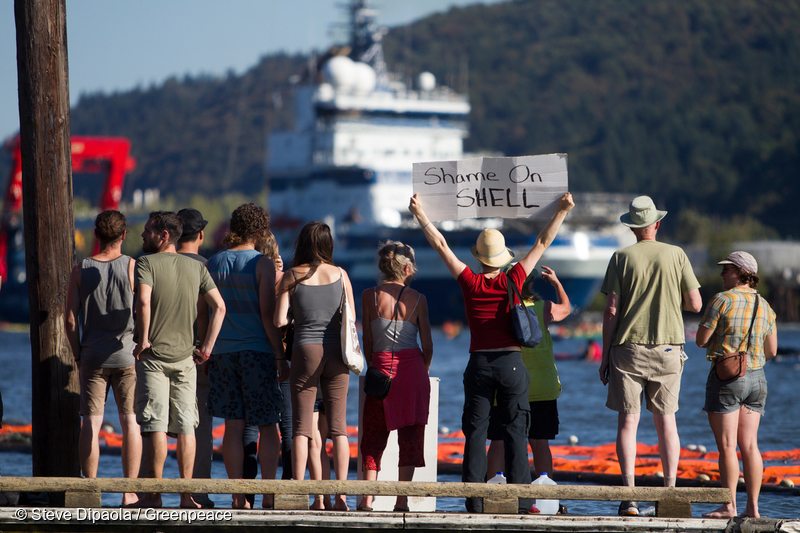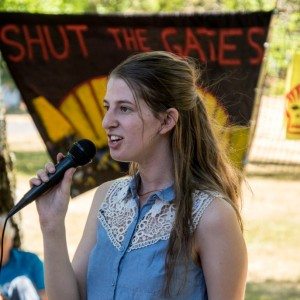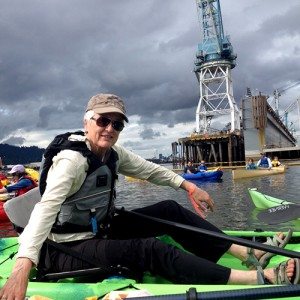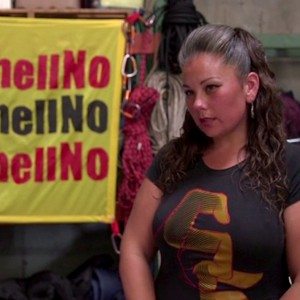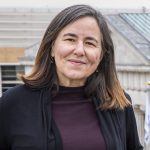We recently interviewed three activists whose inspiring protest delayed Shell’s icebreaker ship from leaving for the Arctic after undergoing repairs in Portland. Their stories serve as examples of the real heart and soul behind the people versus Shell movement.
Mia Reback (left) is a recent college graduate who turned years of volunteer organizing experience into a new job with 350PDX.
Dr. Kelly O’Hanley (center) is a Greenpeace and NoKXL volunteer who has used her expertise in public health to fight fossil fuel infrastructure.
Nancy Pili Hernandez (right) is a Greenpeace activist from California who served as an “anchor” for the climbers who hung from the St. Johns Bridge for 40 hours.
Tell us about yourself as an activist. What is the work you’ve done that you’re most proud of?
Mia: I started organizing around social justice issues at Reed College and quickly recognized the link between social justice and climate change. In 2013, I helped organize an event to blockade the Columbia River from being used to ship coal, oil and gas through the Pacific Northwest, and it was amazing to see the impact my role had on other activists.
Kelly: I’ve been a climate activist for two years after going through a civil disobedience training organized by Greenpeace and local allies in Portland. As a physician, I’ve testified about the health consequences of fossil fuels, such as a proposed propane export terminal in the Port of Longview.
Nancy: I started organizing in high school around social and racial justice issues in Chicano and native communities and I quickly saw environmental justice as a critical part of this work. I painted a mural on the smokestacks of a high school contrasting fossil fuels with renewable energy—and it was promptly painted over.
We know Portland has a strong activist presence on environmental issues, particularly in stopping coal and oil projects from moving forward. What’s happening right now in those fights that you’re working on?
Mia: There has been so much regional organizing over the last few years because there are 28 proposed new or major expansions of fossil fuel projects in the Northwest. These projects could have a carbon footprint five times larger than the Keystone XL, so we’ve protested fossil fuels being shipped by train, natural gas and coal exports, and other infrastructure issues.
Kelly: I’ve also been working on fighting a coal export terminal in the Port of Longview, and I’ve been going door-to-door to talk to neighborhood residents about what is at stake.
Nancy: In the San Francisco Bay Area, I grew up in the shadow of smokestacks from oil refineries. We’re also fighting fossil fuel infrastructure such as crude-by-rail, where I painted a 3,000-foot mural showing an artistic depiction of these trains being replaced by people and clean energy.
There’s a lot of global momentum behind the #ShellNo movement. What about this particular moment and Shell’s presence in Portland has you fired up?
Mia: I definitely feel a connection to the global campaign. There have been thousands of people involved in protests, but that is what it will take to fight a company of Shell’s magnitude. Often one of the frustrating things about our world’s use of fossil fuels is feeling like you are a cog in the wheel of an economic machine that you can’t control, but when it comes to #ShellNo I’m happy to be one cog in a big machine fighting Arctic drilling.
Kelly: I went to the Seattle protests, but had never kayaked before, so I protested from land. The kayaktivists inspired me so much that I immediately signed up for kayaking lessons as soon as I heard the Fennica was coming to Portland. I just knew I had to be part of the team on the water!
Nancy: It’s not just Portland or Seattle—port cities have tremendous power because of how much global commerce flows through them. I was happy to serve as an anchor for the Greenpeace climbers because I was given permission to be there by the millions of people supporting us, not by any government authority.
The fight against Shell’s drilling plans has always been a David and Goliath battle. In what ways have you seen the activist community band together to stand up to this multi-billion dollar corporation?
Mia: I’ve seen a lot of the familiar faces working around the clock to support activists, and I’ve seen new people drawn to the importance of this issue and because they’re drawn to the new tactics like kayaktivism. Most importantly, these protests are making it clear that people of all walks of life understand why slowing climate change impacts them and their communities.
Kelly: The core organizers worked around the clock to make things happen, and we drew support from all around the region. Everyone was so thoughtful—from safety to sunscreen to police relationships. There was a volunteer making sure to take care of all of us in some small way.
Nancy: I have hella love for everyone on the West Coast! We were there in the air, ground and the water to stop Shell. The climbers got a lot of attention, but it took climbers and kayakers to stop the Fennica the first time it tried to leave the port.
The Pacific Northwest activist community has had some big wins against the fossil fuel industry recently. How has that helped you bring this fight to Shell?
Mia: We had already established a network of nine different environmental and faith-based groups who use civil disobedience, and our support for each other in previous actions helped us build the trust and expertise we need to pull this protest off. That network was able to organize quickly when we got word the Fennica was coming to Portland.
Kelly: The whole is bigger than the sum of its parts. Every organization and every volunteer played some small role in making the event happen, and we couldn’t do that without previous experience. We’d worked with many of these groups before, but even new groups showed up with food in hand, ready to help however possible.
Nancy: I’ve learned a lot from organizing in the refinery communities of the Bay Area, but I was able to stand strong because of the support I had from everyone else in Portland.
Why is fighting climate change and saving the Arctic a personal fight for you? What motivates you?
Mia: I look around me and I’m distraught seeing the world I know changing so quickly. I’ve always cared about social justice and I see climate change as a major threat to disadvantaged people all over the world, and it is one more symptom of the complex economic system that prioritizes profit over people.
Kelly: As an obstetrician, I’ve worked on public health in more than 40 countries, so I’ve always cared about people all around the world. Al Gore’s “An Inconvenient Truth” made me concerned about climate change, but it wasn’t until I found opportunities through local organizers that I knew how I could make a difference.
Nancy: I don’t know that there isn’t a parent on earth who wouldn’t sacrifice something of themselves to give their children a better future. We give up time, freedom, and risk bodily harm for all of the next generation.
If one of our readers wants to support the work you’ve done here in Portland, what’s the best thing they can do?
Mia: Get involved in protests against Shell or fossil fuels wherever you are!
Kelly: Get involved in fighting fossil fuels in your community—we need your body and your mind and your help!
Nancy: Join us in defending land and life in any way you can.
